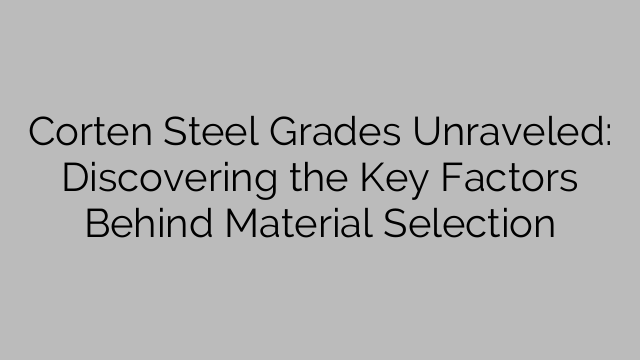Corten steel, also known as weathering steel, has gained immense popularity in the construction industry for its unique appearance and remarkable durability. It has been widely utilized in architectural projects, outdoor sculptures, bridges, and even furniture design. But what exactly are the key factors behind material selection when it comes to Corten steel grades? Let’s delve into the details and unravel the mysteries behind this extraordinary material.
Firstly, it is crucial to understand the composition of Corten steel in order to grasp its remarkable characteristics. Corten steel is primarily comprised of iron, with trace amounts of elements such as copper, nickel, chromium, and phosphorus. These additional elements not only enhance the steel’s corrosion resistance but also contribute to its unique aesthetic appeal.
The primary factor determining the selection of Corten steel grades is the specific environment in which the material will be exposed. Different grades of Corten steel possess varying levels of weather resistance, making them suitable for specific climatic conditions. The most commonly used grades are Corten A and Corten B, both of which exhibit excellent resistance to atmospheric corrosion in various environments. Corten A is primarily used in structures exposed to severe atmospheric conditions, while Corten B is more suitable for moderate environments.
Another determining factor in material selection is the desired lifespan of the structure. Corten steel naturally forms a protective layer of rust on its surface, which acts as a shield against further corrosion. This weathering process gives Corten steel its unique orange-brown patina, creating an aesthetically pleasing appearance that changes over time. While the rust-like appearance may be desirable for some applications, others may prefer to halt or slow down the weathering process. In such cases, special coatings can be applied to Corten steel to retain its original appearance or achieve a desired aesthetic.
Additionally, the structural requirements of the project influence the choice of Corten steel grades. Different grades possess varying mechanical properties, including yield strength and tensile strength. Corten A has a higher yield strength compared to Corten B, making it suitable for applications that require greater structural integrity. Considerations such as load-bearing capacity and resistance to deformation play a crucial role in the material selection process.
It is important to note that although Corten steel grades have excellent corrosion resistance, they are not completely impervious to decay. Factors such as exposure to corrosive chemicals, standing water, or high humidity can affect the material’s performance. Hence, careful consideration of the project’s environmental conditions and proper maintenance is crucial to ensure the longevity of Corten steel structures.
In conclusion, the selection of Corten steel grades involves a combination of factors. The specific environment, desired lifespan, and structural requirements all play a crucial role in deciding the most suitable grade. By understanding these key factors, engineers and architects can make informed decisions and harness the full potential of Corten steel’s unique properties. Whether it’s embracing its distinctive rust-like appearance or protecting it for a more timeless look, Corten steel continues to captivate the design world with its resilience and beauty.

